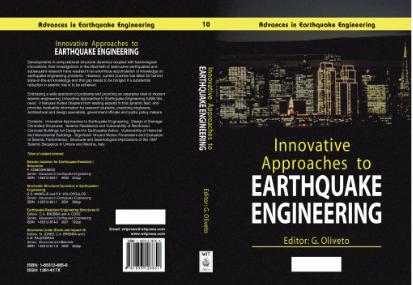|
Preface
Developments
in computational structural dynamics coupled with technological
innovations, field investigations in the aftermath of destructive
earthquakes and subsequent research efforts have resulted in an enormous
accumulation of knowledge on earthquake engineering problems. These
developments have taken place from the second half of last century up to
the present time. Unfortunately, the current state of practice lags far
behind the state of knowledge and this gap needs to be filled if a
substantial reduction of seismic risk is to be achieved. The five chapters
of this book address this problem from different but convergent
directions.
In
the first chapter the earthquake problem is reviewed and its main
objectives are stated. In particular the most reliable innovative
approaches in earthquake engineering are described and the need for their
application in engineering practice is emphasised. The impediments to
their application and the conditions for their efficient use are also
outlined. Amongst the conceptual and technological innovations considered
are Performance Based Earthquake Engineering, Seismic Isolation Systems,
Passive, Active and Hybrid Seismic Protection Systems.
The
second chapter addresses the concept of "Damage Controlled Structures"
or "Damage Tolerant Structures" introduced in the United States and in
Japan after the Northridge (1994) and Kobe (1995) earthquakes. The basic
idea behind this innovation is the separation of the structural system
into two independent parts: one is the elastic primary structure designed
to withstand the vertical service load; the other is the energy
dissipation system designed to resist the lateral earthquake load. The
primary structure can remain elastic even under severe earthquakes while
the energy dissipation devices take care of most of the energy imparted to
the overall structural system by the seismic excitation. In the third
chapter the problem is addressed of the evaluation of the seismic
resistance and vulnerability of reinforced concrete buildings not designed
to resist the seismic action. This is a relevant problem in many urban and
rural areas in earthquake prone regions where seismic regulations were not
enforced at the time of construction either because seismic alertness had
faded after relatively long periods of seismic quiescence or because of
severe economic depression after long wars. The evaluation of the seismic
vulnerability of single or groups of buildings in residential areas may be
of paramount importance in policy decision-making concerning seismic
rehabilitation. The problem is addressed through a case study, which
applies recently adopted procedures and some new ones specifically
developed for the purpose.
The
fourth chapter addresses the theme of seismic risk to historical and
monumental masonry buildings. Because of their peculiar architectural
properties, these buildings need specific procedures for the assessment of
their vulnerability, which are substantially different from those
available for ordinary buildings. Particular aspects of the seismic hazard
that reflect the response behaviour of these structures also need to be
considered. The problem is dealt with specifically with reference to
church buildings and bell towers adopting ad hoc models for the
nonlinear dynamic analyses used in the vulnerability assessments. Specific
measures of the seismic hazard based on significant characteristics of the
ground motion are also developed for the structural types considered.
The
fifth and final chapter considers a long seismic sequence that struck two
adjacent regions in Central Italy from September 1997 to April 1998.The
analysis is particularly relevant because of the damage imparted by
several moderate seismic events to historic town centres, housing, notable
monuments, and works of art. The characteristics of the seismic sequence
are investigated in terms of released energy, magnitude, macro-seismic
effects and seismic history of the affected area. The ground motion
characteristics are analysed from a large set of acceleration records
including significant samples of site effects. The study is concluded with
the analysis of the damage to the existing constructions.
The
topics considered in the five chapters of this book embrace a wide
spectrum of problems in earthquake engineering and provide an extensive
view of modern seismic engineering. The book should prove helpful in
closing the gap that was mentioned initially and should be useful to
research students, professional engineers, government officials and public
policy makers. I wish to take this opportunity to thank all the authors
for their dedication in producing this significant work, especially
Professor Vitelmo V. Bertero, who has enthusiastically dedicated his life
to the advancement of earthquake engineering.
Giuseppe
Oliveto - (Catania, Italy 2002)
|
